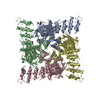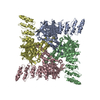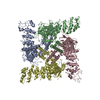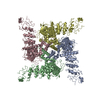+ Open data
Open data
- Basic information
Basic information
| Entry | Database: PDB / ID: 7zje | ||||||
|---|---|---|---|---|---|---|---|
| Title | C16-2 | ||||||
 Components Components | Transient receptor potential cation channel subfamily V member 2,Enhanced green fluorescent protein | ||||||
 Keywords Keywords |  MEMBRANE PROTEIN / temperature sensor MEMBRANE PROTEIN / temperature sensor | ||||||
| Function / homology |  Function and homology information Function and homology informationgrowth cone membrane / response to temperature stimulus / positive regulation of calcium ion import / positive regulation of axon extension / axonal growth cone /  bioluminescence / generation of precursor metabolites and energy / bioluminescence / generation of precursor metabolites and energy /  calcium channel activity / calcium channel activity /  cell body / positive regulation of cold-induced thermogenesis / cell body / positive regulation of cold-induced thermogenesis /  cell surface cell surfaceSimilarity search - Function | ||||||
| Biological species |   Rattus norvegicus (Norway rat) Rattus norvegicus (Norway rat)  Muromegalovirus G4 Muromegalovirus G4 | ||||||
| Method |  ELECTRON MICROSCOPY / ELECTRON MICROSCOPY /  single particle reconstruction / single particle reconstruction /  cryo EM / Resolution: 3.12 Å cryo EM / Resolution: 3.12 Å | ||||||
 Authors Authors | Zhang, L. / Gourdon, P. / Zygmunt, P.M. | ||||||
| Funding support | 1items
| ||||||
 Citation Citation |  Journal: Nat Commun / Year: 2022 Journal: Nat Commun / Year: 2022Title: Cannabinoid non-cannabidiol site modulation of TRPV2 structure and function. Authors: Liying Zhang / Charlotte Simonsen / Lucie Zimova / Kaituo Wang / Lavanya Moparthi / Rachelle Gaudet / Maria Ekoff / Gunnar Nilsson / Ute A Hellmich / Viktorie Vlachova / Pontus Gourdon / Peter M Zygmunt /      Abstract: TRPV2 is a ligand-operated temperature sensor with poorly defined pharmacology. Here, we combine calcium imaging and patch-clamp electrophysiology with cryo-electron microscopy (cryo-EM) to explore ...TRPV2 is a ligand-operated temperature sensor with poorly defined pharmacology. Here, we combine calcium imaging and patch-clamp electrophysiology with cryo-electron microscopy (cryo-EM) to explore how TRPV2 activity is modulated by the phytocannabinoid Δ-tetrahydrocannabiorcol (C16) and by probenecid. C16 and probenecid act in concert to stimulate TRPV2 responses including histamine release from rat and human mast cells. Each ligand causes distinct conformational changes in TRPV2 as revealed by cryo-EM. Although the binding for probenecid remains elusive, C16 associates within the vanilloid pocket. As such, the C16 binding location is distinct from that of cannabidiol, partially overlapping with the binding site of the TRPV2 inhibitor piperlongumine. Taken together, we discover a new cannabinoid binding site in TRPV2 that is under the influence of allosteric control by probenecid. This molecular insight into ligand modulation enhances our understanding of TRPV2 in normal and pathophysiology. | ||||||
| History |
|
- Structure visualization
Structure visualization
| Structure viewer | Molecule:  Molmil Molmil Jmol/JSmol Jmol/JSmol |
|---|
- Downloads & links
Downloads & links
- Download
Download
| PDBx/mmCIF format |  7zje.cif.gz 7zje.cif.gz | 444.6 KB | Display |  PDBx/mmCIF format PDBx/mmCIF format |
|---|---|---|---|---|
| PDB format |  pdb7zje.ent.gz pdb7zje.ent.gz | 352.5 KB | Display |  PDB format PDB format |
| PDBx/mmJSON format |  7zje.json.gz 7zje.json.gz | Tree view |  PDBx/mmJSON format PDBx/mmJSON format | |
| Others |  Other downloads Other downloads |
-Validation report
| Arichive directory |  https://data.pdbj.org/pub/pdb/validation_reports/zj/7zje https://data.pdbj.org/pub/pdb/validation_reports/zj/7zje ftp://data.pdbj.org/pub/pdb/validation_reports/zj/7zje ftp://data.pdbj.org/pub/pdb/validation_reports/zj/7zje | HTTPS FTP |
|---|
-Related structure data
| Related structure data |  14746MC  7zjdC  7zjgC  7zjhC  7zjiC M: map data used to model this data C: citing same article ( |
|---|---|
| Similar structure data | Similarity search - Function & homology  F&H Search F&H Search |
- Links
Links
- Assembly
Assembly
| Deposited unit | 
|
|---|---|
| 1 |
|
- Components
Components
| #1: Protein | Mass: 116426.359 Da / Num. of mol.: 4 Source method: isolated from a genetically manipulated source Source: (gene. exp.)   Rattus norvegicus (Norway rat), (gene. exp.) Rattus norvegicus (Norway rat), (gene. exp.)   Muromegalovirus G4 Muromegalovirus G4Gene: Trpv2, eGFP / Production host:   Saccharomyces cerevisiae (brewer's yeast) / References: UniProt: A0A0G2JSH6, UniProt: A0A7G8ZY66 Saccharomyces cerevisiae (brewer's yeast) / References: UniProt: A0A0G2JSH6, UniProt: A0A7G8ZY66 |
|---|
-Experimental details
-Experiment
| Experiment | Method:  ELECTRON MICROSCOPY ELECTRON MICROSCOPY |
|---|---|
| EM experiment | Aggregation state: PARTICLE / 3D reconstruction method:  single particle reconstruction single particle reconstruction |
- Sample preparation
Sample preparation
| Component | Name: TRPV2-C16-2 / Type: COMPLEX / Entity ID: all / Source: RECOMBINANT |
|---|---|
| Source (natural) | Organism:   Rattus norvegicus (Norway rat) Rattus norvegicus (Norway rat) |
| Source (recombinant) | Organism:   Saccharomyces cerevisiae (brewer's yeast) Saccharomyces cerevisiae (brewer's yeast) |
| Buffer solution | pH: 8 |
| Specimen | Conc.: 0.4 mg/ml / Embedding applied: NO / Shadowing applied: NO / Staining applied : NO / Vitrification applied : NO / Vitrification applied : YES : YES |
Vitrification | Cryogen name: ETHANE |
- Electron microscopy imaging
Electron microscopy imaging
| Experimental equipment |  Model: Titan Krios / Image courtesy: FEI Company |
|---|---|
| Microscopy | Model: FEI TITAN KRIOS |
| Electron gun | Electron source : :  FIELD EMISSION GUN / Accelerating voltage: 300 kV / Illumination mode: FLOOD BEAM FIELD EMISSION GUN / Accelerating voltage: 300 kV / Illumination mode: FLOOD BEAM |
| Electron lens | Mode: BRIGHT FIELD Bright-field microscopy / Nominal defocus max: 2700 nm / Nominal defocus min: 700 nm Bright-field microscopy / Nominal defocus max: 2700 nm / Nominal defocus min: 700 nm |
| Image recording | Electron dose: 48.4 e/Å2 / Film or detector model: GATAN K3 (6k x 4k) |
- Processing
Processing
| Software | Name: PHENIX / Version: 1.19.2_4158: / Classification: refinement | ||||||||||||||||||||||||
|---|---|---|---|---|---|---|---|---|---|---|---|---|---|---|---|---|---|---|---|---|---|---|---|---|---|
CTF correction | Type: PHASE FLIPPING AND AMPLITUDE CORRECTION | ||||||||||||||||||||||||
3D reconstruction | Resolution: 3.12 Å / Resolution method: FSC 0.143 CUT-OFF / Num. of particles: 109000 / Symmetry type: POINT | ||||||||||||||||||||||||
| Refine LS restraints |
|
 Movie
Movie Controller
Controller







 PDBj
PDBj


